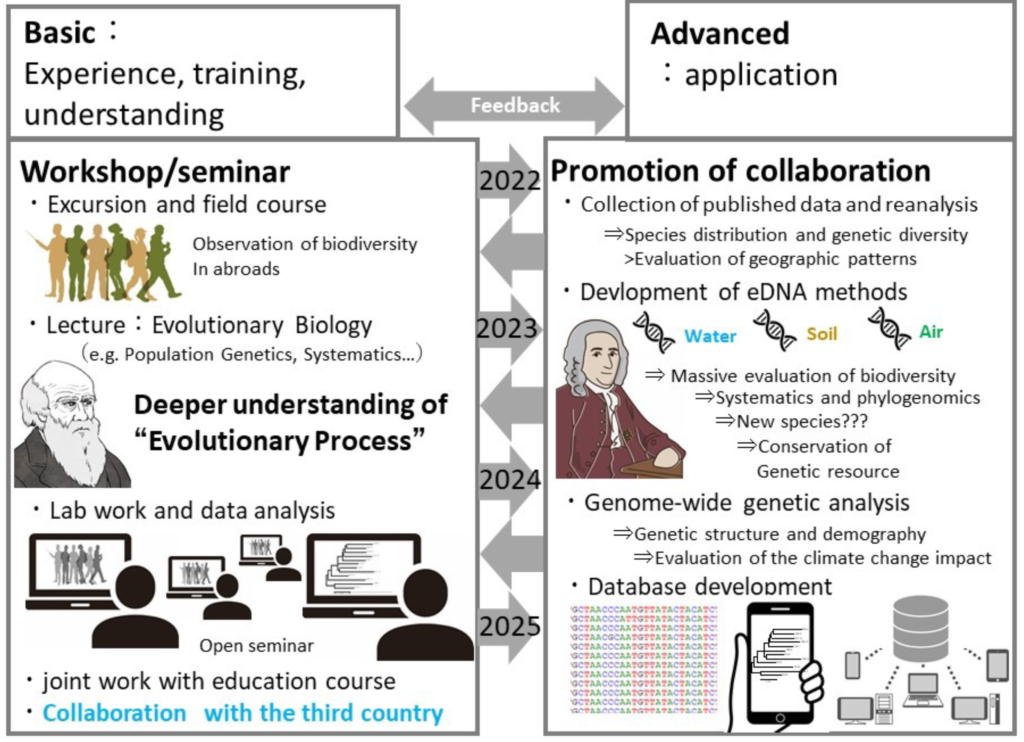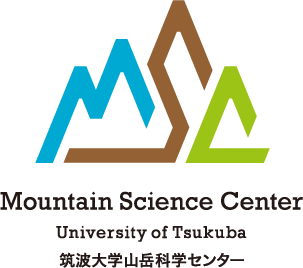Business summary
The University of Tsukuba Mountain Science Center (MSC) advocates a comprehensive science “mountain science” that encompasses various perspectives such as biology, earth science, environmental science, and agriculture. Through wide-ranging training activities, it has contributed to the creation, popularization, research, and education of mountain science mainly in Japan. In the mountainous regions of Asia, where economic development is rapid, the decline in biodiversity due to land alterations such as deforestation and forest fragmentation has become a major problem, and the shift in the distribution of living organisms due to climate change is making this problem even more serious. Biodiversity is the basis of ecosystem services whose importance, including its economic effects, has been widely recognized in recent years, and maintaining Asia’s vast mountain forests is also important as a carbon neutral measure as it is directly connected to the sustainability of human society. However, even in countries and regions that have signed the Convention on Biological Diversity, while genome analysis technology is progressing, efforts to conserve genetic diversity are still insufficient worldwide, and researchers are also voicing environmental concerns. Recent studies have strongly indicated that conservation practitioners do not have a sufficient understanding of evolutionary biology, and lack training and education for genetic diversity assessment. Therefore, the first goal of this application is to establish a joint research and education system with six centers in Asia, with faculty members in the field of evolutionary biology, which MSC is particularly strong in, such as population genetics, systematics, taxonomy, and molecular ecology, taking the lead. This will form the basis for comprehensive genetic diversity assessment, including method development, for various groups of organisms that live in mountainous regions, and for building a database that can be accessed openly by anyone. Furthermore, we aim to expand our international network within the period of this project and become an independent international research exchange base. In particular, from the perspective of nurturing young researchers who will play a central role in the next generation, the second goal is to gain a deep understanding of evolutionary biology, acquire methods for evaluating genetic diversity, and provide educational opportunities. Specifically, we will hold multiple 5-10 day seminars and workshops in Japan and the host countries of young researchers at each center over a three-year period to help young researchers improve their understanding and skills in related fields. This will provide necessary scientific knowledge to various stakeholders at the Asian, national, and local community levels regarding the conservation of genetic diversity, the smallest unit of biodiversity, and contribute to multiple Sustainable Development Goals (SDGs).
(1) Importance
- Approximately 20-25% of the world’s land area is mountainous, and it is said that approximately 12% of the world population lives in mountainous areas, and 40% of people live in the middle or lower reaches of mountains (Watanabe and Yoshino 2004). Therefore, mountainous regions have a close relationship with human society on a global scale (Tsuda et al. 2017, 2019). However, there are concerns that biodiversity in Asia’s mountainous regions is declining due to deforestation, forest fragmentation, and the effects of climate change. The importance of ecosystem services, including their economic value, has recently become widely recognized, but their sustainable use depends on biodiversity, its smallest unit, the environmental adaptability of living things, and populations. Preservation of genetic diversity is essential for survival and evolutionary health. With the rapid progress of genome analysis technology, it is now possible to evaluate genetic diversity at the level of genes, individuals, populations, and ecosystems at an unprecedentedly high resolution (Tsuda 2021). Environmental DNA, which obtains genetic information from soil and other sources, has also become a powerful tool. However, even in the approximately 200 countries and regions that have signed the Convention on Biological Diversity, the response to genetic diversity is still insufficient, especially in terms of monitoring genetic diversity over time and providing genetic diversity training. It has been pointed out that education has not progressed significantly (Hoban et al. 2021). Furthermore, in the field of conservation genetics, there is a disconnect between academia and the real world (Shafer et al. 2016), and too much focus is placed on acquiring skills, while neglecting the necessary understanding and acquisition of theories of population genetics and evolutionary biology. Prominent researchers have pointed out that the therefore, resolving this common problem around the world, “technologies exist but have not been successfully applied to society,” is essential for preserving genetic diversity in the face of environmental change and for creating a sustainable society. In this research, in order to address this problem, we will collaborate with base institutions in Asia to not only evaluate genetic diversity using the latest technology, construct a database, and acquire related techniques, but also acquire theories in related fields to deeply understand it. We also aim to develop young people. The formation of an educational research center for the acquisition system of pioneering practical genetic diversity technology and theory, which is the subject of this research project, will have great academic importance in breaking down the current state of genetic diversity science and developing it in the future.
(2) Significance of conducting research exchanges
Unlike the mid-latitude and northern regions of Europe and the Americas, many of the tropical to cool-temperate regions in Asia’s low to mid-latitudes were never covered by ice sheets during the repeated ice ages of the Quaternary Period, which dates back approximately 2.58 million years. Therefore, Asia is a region that is unique in terms of evolutionary biology, in that living things have been able to survive for long periods of time and achieve independent evolution. Currently, 12 of the 36 biodiversity hotspot regions selected from around the world are located in Asian regions, and there are 8 biodiversity hotspot regions in the 7 countries where this project is based, including Japan. However, in recent years, rapid economic development has caused Asian countries to experience deforestation, forest fragmentation, and other land changes, as well as climate change, and the loss of biodiversity in mountainous regions has become a major environmental problem. In addition, there are many countries in Asia that are still not economically prosperous compared to other countries in the world, and some countries are politically unstable, especially in the Middle East. Furthermore, there are also differences between countries regarding the vaccination rates for the new coronavirus infection, which is currently a global issue. As a result, the reality is that some countries do not have a sufficient environment to conduct biodiversity research, even if they have ambitious young researchers and students. This is based on the “fair and equitable distribution of genetic resources” advocated by the Convention on Biological Diversity and the Sustainable Development Goals (SDGs) “4. Quality education for everyone” and “10. Eliminate inequalities between people and countries.” This means that there are some countries that have not achieved this goal. Japan is an economically successful country in Asia, one of the world’s most mountainous countries, and a country where genetic diversity research is progressing. Therefore, it is important for Japan to take the initiative in promoting education and research for large-scale genetic diversity evaluation and database construction in mountainous areas, and share Japan’s scientific knowledge with Asian countries, thereby contributing to the stability of Asian local communities. This has great significance in terms of contributing to stability and SDGs.



